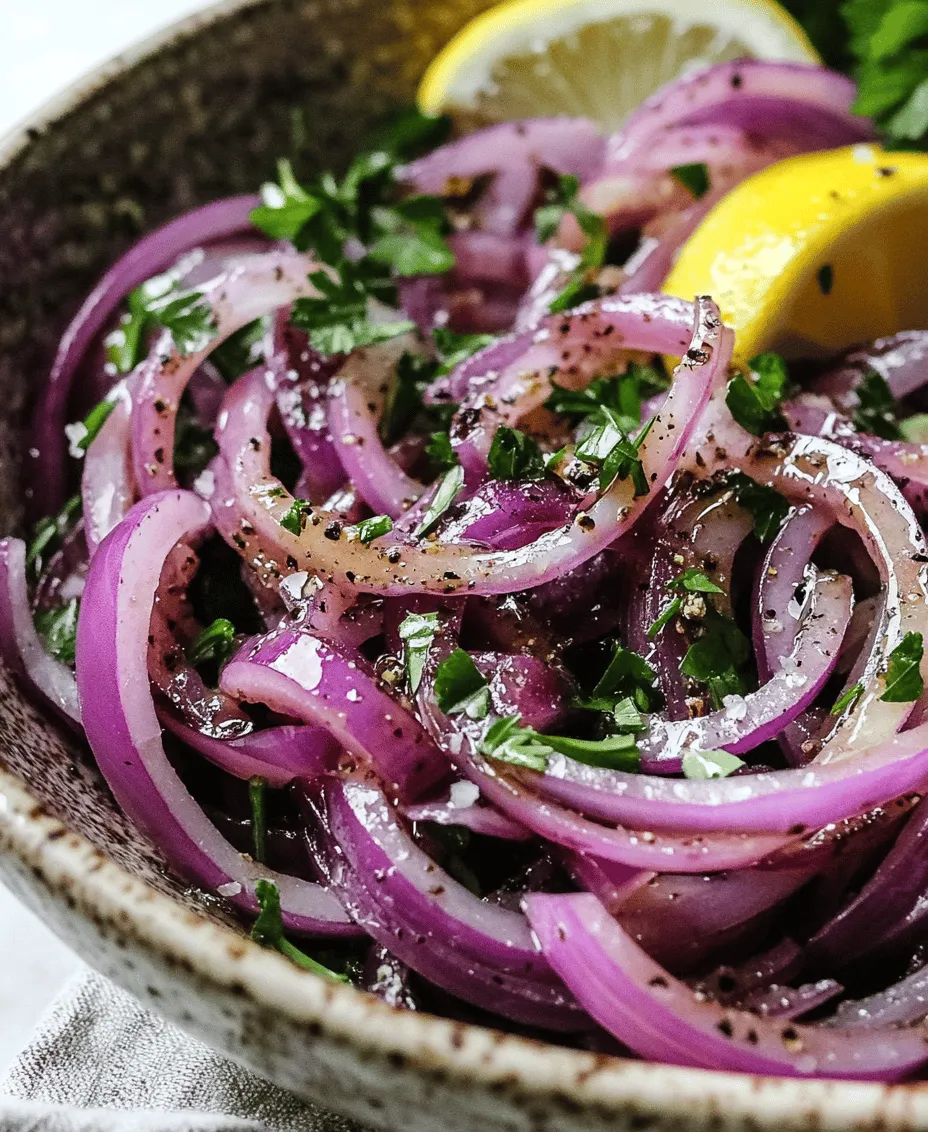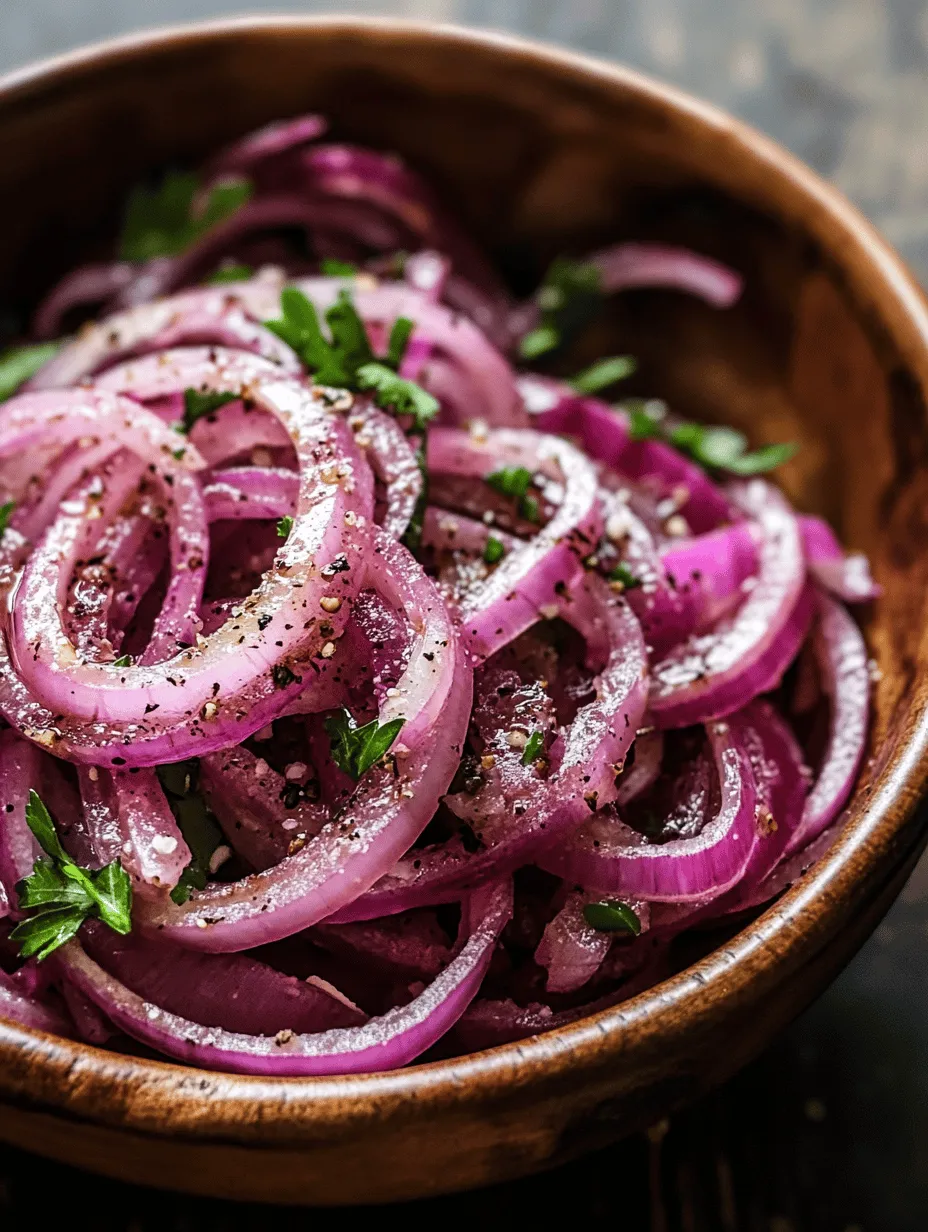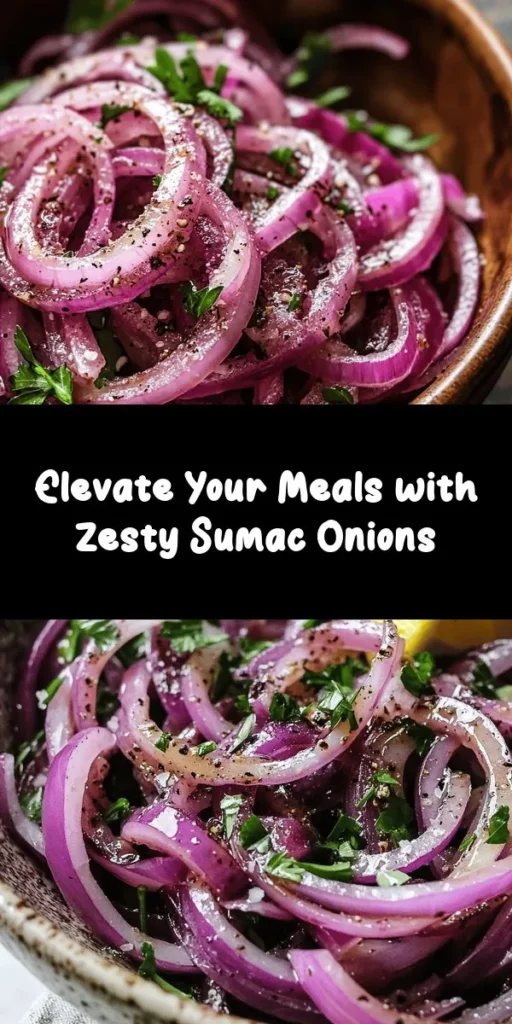Exploring the vibrant world of flavors can lead to delightful discoveries in cooking, and one such gem is the zesty sumac onion dish. This simple yet flavorful recipe highlights the unique tanginess of sumac paired with the sweetness of red onions, creating a versatile accompaniment for various meals. Zesty sumac onions not only enhance the flavors of your dishes but also add a pop of color and a refreshing twist that can elevate even the simplest of meals.
In this article, we will delve into the origins of sumac, the health benefits of onions, and provide a step-by-step guide to preparing this delicious dish. Whether you are looking for a fresh topping for grilled meats or a zesty addition to your salads, zesty sumac onions are sure to impress.
Understanding Sumac: A Flavorful Spice
Defining Sumac and Its Culinary Uses
Sumac is a spice derived from the dried and ground berries of the sumac plant, which is native to the Mediterranean region and parts of the Middle East. The berries have a tangy, lemony flavor that brings brightness to a variety of dishes. In culinary practices, sumac is often used as a seasoning or garnish, adding a unique sourness that complements a wide range of ingredients.
In Mediterranean and Middle Eastern cuisines, sumac is commonly used in salads, marinades, and spice blends like za’atar. It pairs wonderfully with grilled meats, vegetables, and legumes, enhancing the overall taste of the dish. Its versatility in cooking makes sumac a must-have spice in any kitchen, especially for those who enjoy experimenting with bold and vibrant flavors.
Exploring the Cultural Significance of Sumac in Mediterranean Cuisine
Sumac holds a significant place in Mediterranean cuisine, where it is valued not just for its flavor but also for its health benefits. Historically, sumac has been used as a natural preservative and flavor enhancer, making it an essential ingredient in many traditional dishes. Its deep-rooted presence in various cultures reflects the communal and celebratory nature of food, where shared meals often feature the tangy notes of sumac.
In Turkey, for example, sumac is frequently sprinkled over kebabs and salads, adding a refreshing zing that balances the rich flavors of grilled meats. In Lebanon, it is a key ingredient in the spice blend za’atar, which is used to season breads and dips. The use of sumac in these cuisines not only showcases its culinary importance but also highlights the cultural connections that food fosters among communities.
How Sumac Enhances Flavor Profiles in Dishes
What makes sumac particularly appealing is its ability to enhance flavor profiles without overpowering other ingredients. Its bright acidity can cut through the richness of fatty meats, providing a perfect balance of taste. When used in salads, sumac can elevate the freshness of vegetables, making them more vibrant and appealing.
For instance, when combined with zesty lemon juice in our zesty sumac onion recipe, the sumac works harmoniously with the natural sweetness of red onions, creating a dynamic contrast that tantalizes the taste buds. This balance of flavors not only makes dishes more enjoyable but also encourages a more adventurous approach to cooking, inspiring home chefs to explore the endless possibilities that sumac offers.
The Health Benefits of Red Onions
Nutritional Profile of Red Onions
Red onions are not only a staple in many kitchens for their flavor but also for their impressive nutritional profile. They are low in calories while being rich in vitamins, minerals, and antioxidants. A typical medium-sized red onion contains vitamins C and B6, manganese, potassium, and dietary fiber, making them a nutritious addition to any meal.
Furthermore, red onions are known for their high antioxidant content, particularly quercetin, which has been linked to numerous health benefits, including anti-inflammatory and immune-boosting properties. Incorporating red onions into your diet can contribute to overall health while adding a delicious crunch and flavor to your dishes.
Antioxidant Properties and Their Health Implications
The antioxidants found in red onions, especially quercetin, play a vital role in protecting the body from oxidative stress. Oxidative stress is linked to various chronic diseases, including heart disease and cancer. By consuming foods rich in antioxidants, such as red onions, you can support your body’s natural defense mechanisms.
Additionally, antioxidants are known to help reduce inflammation, which can further contribute to improved health outcomes. Regularly including red onions in your meals not only enhances flavor but also provides a health boost, making them a valuable ingredient in your culinary repertoire.
The Role of Onions in Digestive Health and Overall Wellness
Onions, particularly red onions, are an excellent source of dietary fiber, which is essential for maintaining a healthy digestive system. Fiber aids in digestion by promoting regular bowel movements and preventing constipation. A diet high in fiber can also help regulate blood sugar levels and promote a feeling of fullness, making it beneficial for weight management.
Moreover, the prebiotic properties of onions support gut health by nourishing beneficial bacteria in the intestines. A healthy gut microbiome is crucial for overall wellness, as it can influence everything from digestion to immune function. Therefore, incorporating zesty sumac onions into your meals not only adds flavor but also supports your health in multiple ways.
Ingredients Overview
Highlighting Key Ingredients
To prepare zesty sumac onions, you will need a handful of key ingredients that come together to create a dish bursting with flavor. These ingredients include:
– Red onions: The star of the dish, providing sweetness and crunch.
– Sumac: The tangy spice that elevates the flavor profile.
– Olive oil: Adds richness and helps to mellow the sharpness of the onions.
– Lemon juice: Balances the flavors with its acidity.
– Salt: Enhances the overall taste of the dish.
Each of these ingredients plays a crucial role in achieving the perfect balance of flavors and textures in the zesty sumac onions.
The Importance of Quality Olive Oil
When it comes to cooking, the quality of your ingredients can significantly impact the final dish. For this recipe, using high-quality extra virgin olive oil is essential. Not only does it contribute a rich, fruity flavor, but it also provides healthy fats that are beneficial for your heart.
Extra virgin olive oil is packed with antioxidants and has anti-inflammatory properties, making it a healthful choice for drizzling over your zesty sumac onions. Choosing a reputable brand that sources its olives from reputable growers ensures that you are getting the best flavor and health benefits in your cooking.
Choosing the Right Type of Onions: Why Red Onions?
Red onions are the preferred choice for this recipe due to their sweet, mild flavor and vibrant color. Unlike yellow or white onions, which can be sharper and more pungent, red onions offer a delightful sweetness that pairs beautifully with the tanginess of sumac.
Their beautiful hue also adds visual appeal, making your zesty sumac onions not only delicious but also eye-catching. Additionally, red onions retain their color even when cooked, ensuring that your dish remains vibrant and appealing.
Examining Sumac: Where to Find It and How to Use It
Sumac can typically be found in well-stocked grocery stores, specialty spice shops, or Middle Eastern markets. Look for a bright red or purple powder, indicating freshness and quality. When using sumac, it’s essential to remember that a little goes a long way, as its tangy flavor can easily dominate a dish if overused.
In this recipe, we recommend starting with a moderate amount of sumac and adjusting to taste. Its unique flavor will shine through, enhancing the overall taste of the zesty sumac onions without overpowering the sweetness of the red onions.
The Role of Lemon Juice in Balancing Flavors
Lemon juice is a key ingredient in this recipe, providing a fresh burst of acidity that complements the tanginess of sumac. The citrus notes from the lemon juice help to brighten the flavors and enhance the overall taste of the dish.
Using freshly squeezed lemon juice is recommended, as it offers a more vibrant flavor compared to bottled varieties. The acidity of lemon juice also helps to soften the onions slightly, making them more palatable and enjoyable, especially if you prefer a raw onion preparation.
With a solid understanding of the ingredients and their significance, you are now ready to embark on the journey of preparing zesty sumac onions. In the following sections, we will provide you with a detailed step-by-step guide to making this delightful dish, ensuring that you can replicate its vibrant flavors in your kitchen. Stay tuned for the instructions that will help you bring this recipe to life!

Preparation Steps for Zesty Sumac Onions
Gathering Your Ingredients
To prepare zesty sumac onions, you will need the following ingredients:
– 2 large red onions, thinly sliced
– 3 tablespoons of sumac
– 1/4 cup of freshly squeezed lemon juice
– 1/4 cup of olive oil
– 1 teaspoon of salt (to taste)
– Fresh parsley, finely chopped for garnishing
– Freshly ground black pepper (optional)
Make sure to gather all your ingredients before starting the process. This ensures a smooth workflow and helps you avoid missing any crucial components of the recipe.
Step-by-Step Instructions for Marinating Onions
1. Slice the Onions: Begin by peeling the outer skin of the red onions. Using a sharp knife, thinly slice the onions. Aim for even, thin slices to ensure they absorb the marinade effectively.
2. Mix the Marinade: In a mixing bowl, combine the sumac, lemon juice, olive oil, and salt. Whisk the ingredients together until well blended. The sumac will provide a tangy and slightly citrusy flavor that perfectly complements the onions.
3. Combine Onions and Marinade: Place the sliced onions in the bowl with the marinade. Using your hands or a spoon, gently toss the onions in the marinade, ensuring they are evenly coated. This step is crucial for maximizing flavor absorption.
4. Let Them Marinate: Cover the bowl with plastic wrap or a lid and let the onions marinate at room temperature for about 30 minutes. This allows the flavors to meld together, softening the onions and enhancing their taste.
5. Refrigerate for Enhanced Flavor: For a richer taste, consider refrigerating the marinated onions for at least 2 hours or even overnight. The longer the onions sit in the marinade, the more flavorful they become, as the sumac and lemon penetrate deeper into the onion layers.
The Importance of Timing: Marination Explained
Marination is a critical step in this recipe, as it not only infuses the onions with flavor but also alters their texture. The acidic components from the lemon juice act to soften the onions, making them less pungent and more palatable. By allowing the onions to marinate for the recommended time, you ensure that each bite bursts with the zesty, tangy flavors characteristic of this dish.
Flavor Enhancement Techniques with Additional Refrigeration
If you have the time, refrigerating your marinated onions for longer periods can significantly enhance their flavor profile. Here are some tips to maximize the taste:
– Overnight Marination: If possible, let the onions marinate overnight. This will achieve a deeper flavor infusion and produce a more tender texture.
– Toss Periodically: If you refrigerate the onions for an extended period, give them a gentle toss every few hours to redistribute the marinade evenly.
– Add More Sumac: If you prefer a stronger sumac flavor, feel free to add an extra teaspoon or two to the marinade before refrigerating. The additional sumac will intensify the tangy notes.
Final Touches: Garnishing with Fresh Parsley
Once your onions are fully marinated, it’s time to serve. Just before serving, garnish the zesty sumac onions with finely chopped fresh parsley. The parsley adds a pop of color and a fresh herbal note that beautifully complements the tanginess of the marinade. It not only enhances the visual appeal of the dish but also adds another layer of flavor.
Serving Suggestions for Zesty Sumac Onions
Zesty sumac onions are incredibly versatile and can elevate a variety of dishes. Here are some serving suggestions to incorporate them into your meals:
Pairing with Grilled Meats: Chicken, Lamb, and Beef
Zesty sumac onions make an excellent accompaniment to grilled meats. Their tangy flavor cuts through the richness of chicken, lamb, or beef, creating a balanced plate. Simply serve the marinated onions alongside your grilled meats for a refreshing contrast.
– Chicken Skewers: Serve zesty sumac onions with grilled chicken skewers for a Mediterranean-inspired meal.
– Lamb Chops: Pair with juicy lamb chops to enhance the savory flavors.
– Beef Kebabs: Adding zesty onions to beef kebabs creates a delightful flavor combination.
Incorporating into Salads for Added Texture and Flavor
These marinated onions can also be tossed into salads for a flavor boost. Their zesty profile adds depth, while the crunch elevates the salad’s texture.
– Mediterranean Salad: Mix zesty sumac onions with tomatoes, cucumbers, feta cheese, and olives for a vibrant Mediterranean salad.
– Grain Salads: Add to grain-based salads, such as quinoa or bulgur, for an earthy, tangy flavor.
– Green Salads: Toss into mixed greens with a light vinaigrette to enhance freshness.
Using as a Side Dish with Mediterranean Favorites
Zesty sumac onions can serve as a delightful side dish with your favorite Mediterranean meals. Their unique flavor can complement a variety of dishes:
– Falafel Plates: Serve alongside falafel, tahini sauce, and pita bread for a satisfying meal.
– Stuffed Peppers: Pair with stuffed bell peppers filled with rice, herbs, and spices.
– Roasted Vegetables: Add to a platter of roasted vegetables for a colorful and flavorful side.
Creative Ideas for Using Zesty Sumac Onions in Wraps and Sandwiches
The zesty flavor of these marinated onions can elevate any wrap or sandwich. Here are some creative uses:
– Pita Wraps: Include zesty sumac onions in pita wraps with grilled vegetables and hummus for a refreshing bite.
– Burgers: Top your beef or veggie burgers with the marinated onions for an unexpected twist.
– Tacos: Use as a garnish in tacos for a tangy crunch that complements the fillings.
Storage and Shelf Life
Best Practices for Storing Zesty Sumac Onions
To maintain the vibrant flavors and crunch of your zesty sumac onions, proper storage is essential. Here are some best practices:
– Use Airtight Containers: Transfer the marinated onions to an airtight container to keep them fresh and prevent them from absorbing odors from the refrigerator.
– Keep the Marinade: Ensure that the onions remain submerged in the marinade while stored, as this will help preserve their flavor and texture.
Understanding How Long They Last in the Refrigerator
When stored correctly, zesty sumac onions can last in the refrigerator for up to one week. After this time, they may begin to lose their crunch and flavor. Always check for signs of spoilage before consuming.
Tips for Reviving Leftovers
If you find that your zesty sumac onions have lost some of their flavor or crunch after a few days, don’t worry! Here are some tips to revive them:
– Toss in Fresh Lemon Juice: A splash of fresh lemon juice can brighten the flavors and add an extra zing.
– Add Fresh Herbs: Incorporate freshly chopped herbs such as parsley or mint to refresh the dish.
– Re-marinate: If the onions are still good but lacking flavor, consider adding them back into a fresh marinade for a few hours.
Conclusion
Zesty sumac onions are not just a garnish; they are a celebration of flavor and health that can elevate any meal. With their vibrant taste and numerous health benefits, these marinated onions represent a perfect blend of simplicity and sophistication in the kitchen. As you incorporate this dish into your culinary repertoire, you’ll discover its versatility and charm, making it a staple in your Mediterranean-inspired meals. Enjoy the burst of flavor and the delightful crunch of zesty sumac onions, and let them inspire your cooking adventures.



